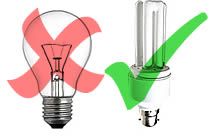 Cost-benefit analysis
Cost-benefit analysis
An example: Changing the light bulbs
Suppose you want to decide whether to buy ten ordinary (incandescent) 60-watt light bulbs or ten 11-watt energy-efficient light bulbs. The energy saving bulbs cost twice as much as ordinary ones. An 11-watt energy-efficient light bulb gives out the same amount of light as the ordinary 60-watt bulbs.
Cost to your household
10 energy efficient bulbs @ £1 each cost £10
10 ordinary light bulbs @ 50p each cost £5
- The energy efficient light bulbs will last 6 years (based on the light being ‘on’ for an average of 3 hrs each day). The ordinary light bulbs will last 1 year if they are on for the same amount of time.
- The yearly spend on light bulbs will therefore show a saving of £3.30.
- Swapping to a low energy bulb saves 49 (60-11) watts per light bulb
If the 10 low energy light bulbs are on for 1000
hours every year, how many kilowatt hours of energy
are saved?
-

-
Answer = 49 watts x 10 (bulbs) x 1000 hoursi.e. 490 kWh.
1 kWh is the ‘unit’ of electricity on your bill,
the cost of a unit varies but is roughly 11p.
How much will you save in one year?
-

-
Answer = In one year the saving on your electricity bill will be about 490 x 11p i.e. £54.00
You should have found that the total saving on
your household bills will be about £57.30
There is a drawback: dimmer switches cannot be
used with the energy-saving bulbs.

Benefits to the environment
- Saving electricity means reducing emissions. Taking account the mixture of power stations that generate electricity in the UK it can be shown that generating1kWh produces 0.43kg CO2.
- Changing the light bulbs will therefore reduce the amount of CO2 emitted to the atmosphere in one year by 490 kWh x 0.43 i.e. 210kg CO2 .
(This is about the same amount as a typical family car generates when it travels 585 miles.) - Using less electricity will also means burning less fossil fuel.
- Changing to energy saving bulbs seems to be a win-win solution, BUT there is a cost to the environment.
Cost to the environment
- Each energy efficient bulb contains a very small amount of mercury (less than 5mg per bulb). If the bulbs are thrown away with household waste this will enter the environment.
- In January 2007 new regulations came into force in the UK to implement the EC Directive on Waste Electrical and Electronic Equipment (WEEE). The aim is to reduce the impact of WEEE going to landfill. To do this the regulations will
- make producers pay for the collection, treatment and recovery of waste
- oblige distributors to take back the equipment free of charge when the consumer wants to throw it away.
- The regulations cover energy efficient light bulbs
|
SITES FOR FURTHER INFORMATION
You can find out more about WEEE  here here
|

What's your opinion?
Average rating




Current rating: 5/5 (from 1 votes cast)